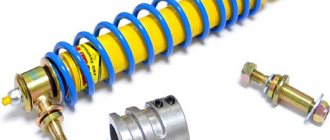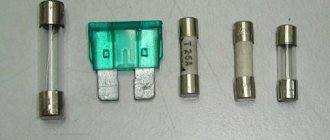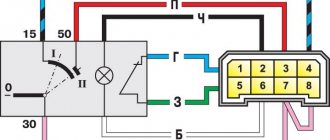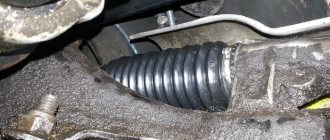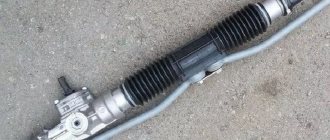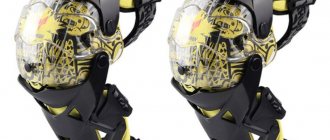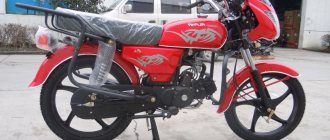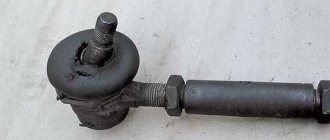The steering damper is an important element of the safety control of cars and motorcycles, most often found on the latter, but which can also be seen on SUVs. In particular, it is used on SUVs equipped with a solid front axle, prepared to overcome difficult terrain in areas where there are no roads. However, a steering damper can also be installed on passenger cars, for example, it is installed on the Lada Granta and some other passenger models.
Why do you need a steering damper?
The purpose of this damper is to dampen lateral vibrations of the steering elements, which can lead to dangerous consequences.
If we broadly take the need to use the device on certain types of vehicles (we are talking about jeeps prepared for serious off-road use), then we can say the following: the element is capable of absorbing sharp, sudden, and therefore extremely undesirable vibrations of the steering rods in the plane, which can occur after the vehicle drives along uneven roads (off-road), which can transfer significant shock loads to the steering elements and the front axle.
photo: autokult.pl
As you can see in the photo above, the steering damper is mounted transversely and horizontally between the front wheels, which is completely different from a conventional shock absorber. The principle of its operation is exactly the same as that of every shock absorber on a wheel, but its task is different.
A loose steering wheel (wobbling on a motorcycle) and what to do about it
ABOUT STEERING DAMPERS
Anyone who has ridden a modern sportbike knows from personal experience or has certainly heard from friends that when landing after a “candle” or simply on an uneven road, the front wheel begins to “sausage”: the steering wheel convulses from lock to lock, and often such a “circus” ends in a fall. If you think that this happens only to “dummies,” then you are mistaken. The reason for the “sausage” lies not so much in the driver’s driving abilities, but in the design features of modern sportbikes. To achieve sharp controllability of the bike, the angle of the steering column is made small (22-24 degrees from the vertical). And the smaller it is, the smaller the fork offset and the less force returns the front wheel together with the fork to its original position after driving over uneven surfaces.
If we remember the physics of vibrations, it becomes clear that “wobbling” (as professionals call this phenomenon) is nothing more than the inevitable harmonic resonant vibrations of the fork. For them to occur, you need a strong initial impulse - be it hitting a bump or touching the road with the front wheel slightly turned relative to the direction of movement after “goat”. And for the oscillations to continue, the action of an external quasi-elastic force is required (sorry for the “scary” terminology, but “you can’t erase the words from the song”), which is the tense hands of the pilot trying to stabilize the uncontrollable bike.
In 1996, Suzuki made a chic motorcycle TL1000S - a magnificent, angry “liter” twin, with a narrow and light aluminum frame, sporty chassis geometry. The motorcycle, without straining, “goated” off the gas in the first two gears. Accordingly, during active driving, exiting a turn on one rear wheel was “supplied” with the motorcycle with free cheese in a colorful package. The debut was successful - everyone wrote laudatory reviews and sang praises. But when the motorcycle went on sale, problems began: people began to fight on it. And with alarming regularity. (How did the experts of motorcycle publications overlook the defects of the car during the presentation tests?.. It’s simple - that’s why they are experts because they know how to ride and do not attach importance to minor shortcomings, considering them features or nothing more than “character traits” of the motorcycle, but in their hands For the average user, little things lead to serious consequences). The Japanese concern miscalculated the geometry of the steering system. The small offset of the front fork, good bearings in the steering column and a powerful engine combined into a killer cocktail that won the title “Sausage of the Year.” And to this day the TL1000S is remembered as the most “sausage” motorcycle of all time.
There are four terms in English, and all of them are translated into Russian as “sausage”. Let's look at them in order of increasing effect.
1. Shimmy. This is a slight shaking of the steering wheel when driving over uneven surfaces. The phenomenon occurs when you run into a line of cut asphalt longitudinal to the direction of movement or a crack in the pavement. As a rule, shimmy does not threaten anything dangerous - it just causes shaking of the steering wheel. Unpleasant, but not fatal. Try not to strain your hands - it will fade away on its own.
2. Wobbling. “Damn it!” It has nothing to do with it, just like the Russian “vobla”, if you decide that the phenomenon designated by this term is akin to the movement of fish in water. Wobbling is already resonant oscillations. They are “treated” by adding gas or applying the rear brake. A mechanical means of combating the phenomenon is a steering damper: it causes the wobbling to “sour” on the second or third vibration or will not allow it to occur at all.
3. Weave. It can transform into wobbling and develop into rear wagging if you squeeze the steering wheel very tightly with tense hands or if you tighten the damper adjuster to the maximum. This is when not only the steering wheel shakes, but the whole motorcycle along with the motorcyclist “sausages”. To get out of these fluctuations, you need to loosen your grip on the steering wheel, relax your arms and shoulders, and slow down a little with the rear brake. And do not tighten the damper adjustment all the way!
4. "Tankslapping" This is already incurable and with a 95% probability leads to a fall. The system has reached the maximum amplitude of resonant oscillations, the steering wheel has already been torn out of my hands and is beating from rebound to rebound. The only thing you can do is press the rear brake. But there is no hope that this will help. Get ready to start sliding along the asphalt or pirouette in the air (my condolences to you). Nothing can save you from this - neither a damper, nor tightening the steering column bearings, nor steering with relaxed hands. None of the motorcycles are free from such troubles; another thing is that the probability of getting into such a situation is very small, and the more modern the motorcycle, the less it is.
But let's return to Suzuki. To eliminate the problem with the TL1000S (on which wobbling often developed into tankslapping), they began to install a steering damper on the motorcycle as standard. I can’t say that it reduced the surprises with the device’s controllability to nothing, but it helped significantly - the complaints stopped. Since then, Suzuki has installed dampers on all sports motorcycles. Just in case.
These are the simplest hydraulic dampers - non-adjustable (Fig. A). The rod with the piston (2) runs in a closed cylinder housing (1), with oil inside. The piston contains bypass valves (4). Oil seals (3) are on both sides of the housing; they prevent oil from leaking out. Maintenance-free, but inexpensive, and works reliably. It is not very convenient that each model requires valves with individual characteristics and oil of “individual” viscosity. And it is impossible to regulate on your own. Nominally there is a device, it works, but many are not satisfied. Therefore, it is often replaced with adjustable (Fig. B and C) options.
Bypass valve cross-section adjustments can be built into the piston (Figure B) and the adjustment screw (5) can be brought out to the end of the rod (HyperPro uses this solution). But you can do it differently - make the piston solid, machine a “bypass channel” (6) in the body and install a valve with adjustment (4 and 5) on the body (1), as Ohlins does. The second option is somewhat more difficult to manufacture, but more reliable in operation - this is why Yolins dampers are considered the most reliable in Russia.
DEAN, Moscow
What is a steering damper used for?
photo: uaz.ru
Thus, the steering damper can be thought of as a kind of shock absorber operating in a horizontal plane (which it is from a technical point of view). But why is it needed?
In particular, if we take the main purpose of using a horizontally located damping element, we can say the following: the main purpose of the damper is to dampen unwanted vibrations of the steering elements, which can greatly interfere with the control of the car due to the accumulation of driver fatigue , and also affect the wear of suspension elements and steering, as well as other parts of the car, in particular tires.
Its use is especially relevant on uneven surfaces, which, when the car passes them, respond by twitching and moving the steering wheel from side to side. The driver has to fight with them, often jeopardizing the safety of driving the car.
Also part of the work of the steering damper is to return the steering wheel to its original position in order to keep the car in a straight line.
But, perhaps, the most important part of the damper’s work is to increase the vehicle’s directional stability when driving on asphalt roads and to avoid such a phenomenon as shimmy (also known as wobbling, in slang - “sausage”) - spontaneous vibrations of the front wheels when steering, arising from - for fastening play, deformation of the wheel support and lateral vibrations of the vehicle - a negative and extremely dangerous phenomenon:
Video taken from YouTube channel “Rare Parts Inc”
As you can see, with this phenomenon, the wheels, steering, and suspension begin to move uncontrollably in a horizontal plane, increasing their amplitude and trying to turn the car around its axis. It is almost impossible to drive a car in such a state.
The shimmy phenomenon is caused when hitting an obstacle or after one of the front wheels falls into a hole.
The installation of a steering damper, also called a shimmy damper, can eliminate or minimize the negative behavior of the front suspension. It is this that will dampen all vibrations that will subsequently arise between the steering rods and the bridge. see also
Steering end: principle of operation, design and diagnostics
From this we can draw several important conclusions so that your SUV does not find itself in such situations:
1. It is important for jeepers to ensure that the front suspension and steering are in good working order;
2. Monitor the serviceability of the steering damper;
3. Do not make unauthorized changes to the steering elements and suspension of the car (tuning).
What is a motorcycle steering damper used for?
Should I install a motorcycle steering damper or not?
This question comes up all the time among motorcycle fans. Often opinions on this matter differ. Because in this tuning it is not the quality of the damper that is considered important, but the quality of the motorcyclist himself. Based on the results of road tests of bikes, the stability of vehicles at high speed is constantly assessed. So, some motorcycles yaw, while others move as if on rails.
Stability of motor vehicles.
The bike constantly yaws, but the amount of this varies and depends on a number of factors:
- condition of the roadway;
- tire wear;
- speed;
- suspension geometry.
The wheel and front fork perfectly eliminate surface unevenness, but the vehicle suspension only works in the vertical plane. Therefore, if the motorcycle hits a bump, there will be a slight displacement of the wheel even in the horizontal plane. If you need MTF xenon, then you should visit the website www.autoglim.ru.
If the wheel of a motorcycle rotates strongly, then it has a gyroscopic effect, therefore, it tries to return to a neutral position corresponding to the tilt of the vehicle. However, while it is spinning, another bump may come across, and again the wheel will move a little. This is a normal process that occurs constantly when the vehicle is moving.
When a motorcycle rides on a flat surface, the motorcyclist does not feel all these vibrations: the impression of a straight ride is created. Of course, if the gyroscope does not return the wheel to a neutral position, then we cannot talk about any “hands-free” movement. It follows that, in principle, the motorcycle has stability, and it constantly tries to maintain a straight ride.
But it remains stable until someone tries to turn the steering wheel sharply. And while the bike has the correct weight distribution along the axes, the gyroscope puts up strong resistance when trying to change the position of the axle, which is what happens when the rider turns the handlebars.
The effect of the gyroscope increases with increasing speed of turning of the body, therefore, the higher the speed, the more difficult it is to turn the steering wheel of a motor vehicle. If you try to change the position of the gyroscope axis with a sharp movement, this will result in damped oscillations with a large deviation.
The situations that cause these vibrations vary, but usually they depend on the unloading of the front wheel. At such a moment, the danger of a sharp shift in the horizontal plane is especially likely.
Today, these problems are solved with the use of steering dampers. These are small devices that are similar in design to shock absorbers; they are able to dampen unnecessary vibrations of the fork. With the help of a steering damper, sharp vibration of the fork in the horizontal plane is removed. This device will also prevent these vibrations from forming.
Under typical conditions, a good motorcycle steering damper is unnoticeable and does not create any additional drag when riding. However, he is obliged, he is constantly ready, in order to remove strong hesitation at a crucial moment.
Basically, dampers need to be installed on modern sports bikes with their powerful engines that easily lift the bike onto the rear wheel with the rider, and small fork angles, as well as providing them with sharp handling. It goes without saying that the sharper the handling, the more the fork is affected by uneven road surfaces.
Of course, the device will not be able to completely damp out vibrations, but it can significantly reduce their amplitude and frequency. In this case, you don’t have to rely solely on the damper, because if the driver makes mistakes, for example, holding the steering wheel very tightly, then the bike will behave unstably and with the device.
Types of manual dampers.
Nowadays, two types of dampers are mainly in demand: telescopic and rotary. Telescopic devices resemble ordinary shock absorbers: a rod moves in the cylindrical body of the damper, on which a piston is fixed.
Installation of the device.
Telescopic dampers are installed in different ways. It all depends on the motorcycle model and mounting kit. Typically installed along the top brace of the fork. But there are different options, for example, fix the body on the frame and connect the rod using a lever with a fork or vice versa.
Rotor damper type.
Devices of this type are completely different from telescopic dampers. However, their operating principle is the same. This type of damper has a more durable design and excellent resistance to damage in an accident, so it is preferred to be used on off-road motor vehicles, and is also used on sport bikes.
The body of this device is often mounted on the upper cross member of the fork, and the moving axle is connected using a lever to the frame.
Features of the work.
The damper is a container filled with oil. It is divided by a movable partition into two chambers. There are also special valves, the size of which can be adjusted. A partition moves in the container, changing the volumes of the two chambers and forcing the oil to circulate through the hole.
Depending on the design of the device, the partition is connected to a rod that moves forward and then back (telescopic) or to a rotating axis (rotary).
The damper is a safety detail.
Undoubtedly, a steering damper, when installed correctly, is a safety detail, and you should not skimp on it. Almost all riders use this device on their bikes. But they have problems with suspension vibrations, which can be seen at any race.
Operating principle of the steering damper
According to the principle of operation, the steering damper is both externally and internally similar to shock absorbers. Technically, this is a shock absorber, that is, a container divided into two parts by a rod, with a certain number of holes through which liquid - oil - flows at a certain speed. The resistance created by the fluid dampens the resulting vibrations on the wheels, which are transmitted to the steering wheel, making the ride not only more comfortable in any conditions, but also safer.
Cover: patcoroffroad.co.za
Homemade steering damper: an experiment of unprecedented greed
The desire to have a steering damper on the B2, “like all the boys,” has been with me for a long time. Once, from the well-known and respected Armen (Ammonia), I almost bought it, but the amphibian, already tormented by the cost of ordering chassis parts, did not agree to the new expenses. Taking into account delivery at that time, the amount was approaching $400 and greed won.
And so, I finally decided to experiment. I looked at pictures from the USA, read topics on UAZbook. I decided that my steering damper must be homemade, collective farm, easy to install and effective. We'll see what comes of this in a couple of weeks.
The basis of the damper is a car shock absorber. The main requirement for it is approximately the same work on compression and rebound. That is, the force should be approximately the same in both directions. Since we are having an experiment here, I went the cheapest, or rather free, route. A used rear shock absorber from a VAZ-2106 was used (new in the store for 490 rubles) with a fastening in the form of 2 “ears” and lightly tinted with the available blue “Hamerit” paint. Fastening with ear rings seemed preferable to me from the point of view of convenience - you can use the original bolt for the shock absorber.
In order for a shock absorber to work effectively and for a shorter period of time, its axis must deviate as little as possible from parallel with the steering rod, to which one end of the shock absorber is attached. It turned out to be very convenient to attach the second end of the shock absorber to the stabilizer rod. They are parallel to the tails and are quite thick. And pictures from some American manuals indicate this method as characteristic of almost all Fords and Jeeps of the 70s and 80s. Well, since Ford and Chrysler can do it, then it will do for me too.
We’ve decided on the setup, all that’s left is to figure out how to mount it. And also nothing new. In the pictures, all the beauty is attached to the rods with clamps and support platforms. I found the closest and most obvious thread clamps at a hardware store. There they are called “metal sling clamps”. I measured the diameter of the rods and went to the store to pick out what would fit. I found it for 300 rubles in total, with groovers and spacers. I took 4 pieces, although only 3 were useful. About these:
Next, my path lay in the metal rolling shop, where they cut plates for fasteners with a guillotine and made holes in them with a drilling machine. I used 4mm thick metal, although I think 3mm would be sufficient. In total it cost 200 rubles including materials. All that remained was to assemble it all and put it on the car.
Since the mount is extremely primitive, adjusting the position (so that the shock absorber does not interfere with wheel rotation) took about twenty minutes. Now it all looks something like this:
I have driven all this for less than 100 km and it is too early to talk about the reliability and durability of the structure. But the first impressions are already there.
The car has become somewhat more “tram-like”. That is, he now walks more steadily in a straight line, requiring fewer corrective movements of the steering wheel. The car became noticeably calmer on the road, and the “jerky” steering behavior decreased. If you know what a short, tall and narrow SUV on non-standard wheels is, then you will understand what I'm talking about.
So far, I have a feeling that 600 rubles and two hours of work were not in vain. We'll see later.
In principle, if anyone needs it, I can upload the drawing here. Although it is as simple as... like a rectangle with holes
UPD: the shock absorber stroke, by the way, turned out to be even excessive for my purposes.
In no wheel position does the shock absorber compress or extend to the edge. Modified on July 18, 2013 by Kotozver (see edit history)
Steering column damper, what is its purpose?
This option can be found in factory models of sportbikes, and on the race track you are unlikely to find a model without a damper. Cross-country motorcycles are also equipped with them. Someone will throw up their hands, saying - what, why?
A damper is a device that helps smooth out steering wheel vibrations. This is not a panacea for wobbling, but a useful gadget for short and nimble motorcycle models whose forks do not have much forward reach. Additional help for beginners who, in any incomprehensible situation, begin to either struggle with the steering wheel or distort it.
The principle of operation is close to the operation of shock absorbers; it is not for nothing that Damper is translated as “damper”. One part of the device is attached to a stationary part of the motorcycle, usually the frame. The second part is attached to the steering column, mainly to the yoke. Mounting options vary by manufacturer and model. Before buying a damper, you will have to spend a lot of time to choose the right one and not make mistakes with the fasteners. In any case, the vibrations of the steering wheel are transferred to the damper, which, as it were, absorbs it.
By structure there are:
- Rod ones, they are also telescopic
- Rotary
- Spring
- Adjustable
- Not adjustable
Long forks are inferior to short forks in handling, but forks with greater offset and weight suffer less from shaking. Considering the wheels, which on choppers and tourists are much more massive than on sportbikes or cross-country bikes, the heavy steering base itself partially serves as a damper. The weight makes the bike more stable, allowing it to hold up more confidently when the handlebars shake.
Some motorcyclists complain that with the installation of a damper it has become more difficult to control the motorcycle, because the turning radius has increased and the steering wheel is less responsive. A standard complaint when the pilot has poorly configured the system or has not yet experienced it.
The damper is useful because it gives the pilot's hands a rest. Yes, this is exactly the case when you allow yourself the luxury of letting go of the steering wheel and straightening your stiff back, without fear that the axle will turn sharply due to minor shaking or unevenness of the road.
Damper calibration allows you to tune in to a specific driving pattern. The less the damper is tightened, the easier the motorcycle steers. Leaving the settings at minimum is a good choice when driving in dense traffic between rows or when pulling out of a parking lot, as an option when the road conditions are bad and low speed.
A tightly tightened damper takes away the freedom of sharp maneuvers, but they are not needed if you are going to burn a tank of gas and rubber on the track. Smooth movements are all you need. And the turbulence of light shaking will be absorbed by the installed system.
Moreover, the damper dampens shocks and twitches when the wheel hits light uneven surfaces. Of course, it won’t save a crossman when jumping over bumps, but these brave guys also don’t mind using rotary devices to make travel easier and the steering wheel doesn’t turn too much. By the way, it is rotary dampers that are gaining maximum popularity due to their survivability in case of motorcycle falls.
Justified claims of the urban rider will be grievances about the vulnerability of the rod structure during falls and the inability to find the optimal mode, in which it would be comfortable to quickly maneuver and completely extinguish the wobble. Alas, you will have to choose between freedom of movement of the steering wheel and fixations against shaking.
Our modest corner, for those who like to read interesting articles about motorcycle sports, driving techniques, various nuances and usefulness...

